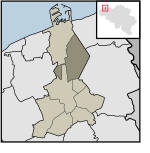SM UB-59
1917 shipsGerman Type UB III submarinesMaritime incidents in 1918Ships built in Bremen (state)U-boats commissioned in 1917 ... and 3 more
U-boats scuttled in 1918World War I shipwrecks in the English ChannelWorld War I submarines of Germany

SM UB-59 was a German Type UB III submarine or U-boat in the German Imperial Navy (German: Kaiserliche Marine) during World War I. She was commissioned into the Flanders Flotilla of the German Imperial Navy on 25 August 1917 as SM UB-59.She operated as part of the Flanders Flotilla based in Zeebrugge. UB-59 scuttled 5 October 1918 off Zeebrugge at 51°19′N 03°12′E during the evacuation of Belgium by German forces.
Excerpt from the Wikipedia article SM UB-59 (License: CC BY-SA 3.0, Authors, Images).SM UB-59
Lanceloot Blondeellaan, Bruges
Geographical coordinates (GPS) Address Nearby Places Show on map
Geographical coordinates (GPS)
| Latitude | Longitude |
|---|---|
| N 51.316666666667 ° | E 3.2 ° |
Address
Lanceloot Blondeellaan
Lanceloot Blondeellaan
8380 Bruges
West Flanders, Belgium
Open on Google Maps









